Business
40+ Content Writing Statistics to Help Boost Your Business
Published
5 years agoon

Back in 2019, the content marketing industry is expected to be worth $412.88 billion by 2021. Fast-forward, we’re months into 2021. How far has the content writing industry reached? There’s one thing we know for sure, in online businesses, content writing is at the top of the throne. Here’s the latest content writing statistics to help boost your business:
Content Writing Statistics – Marketing
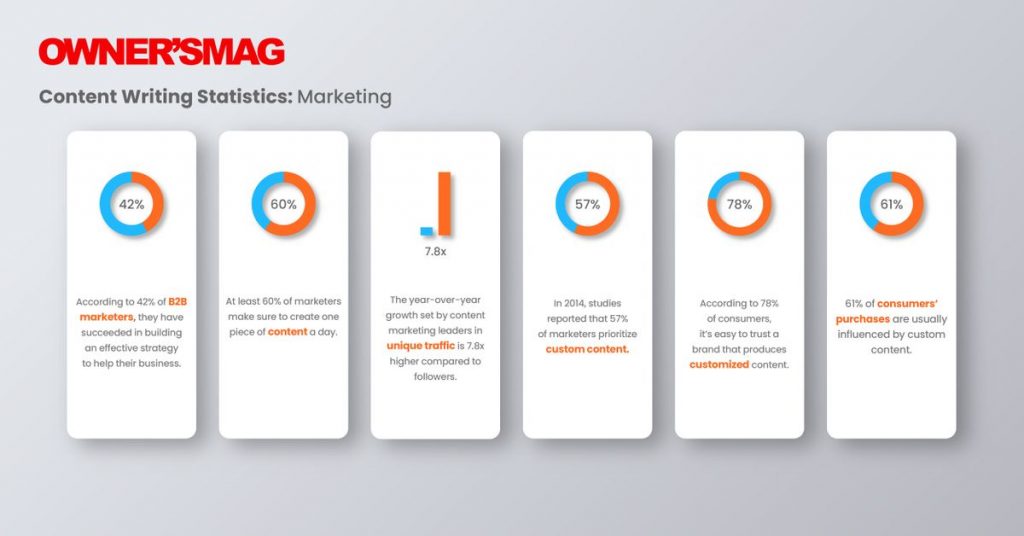
- CMI
Successful content marketing takes time and effort to produce quality results for your brand. However, according to 42% B2B marketers, they have succeeded in building an effective strategy to help their business.
- eMarketer
As they say, consistency is vital for content marketing. Did you know that at least 60% of marketers make sure to create one piece of content a day? This helps them stay relevant to the search engine and social media’s algorithm.
- Aberdeen
The year-over-year growth set by content marketing leaders in unique traffic is 7.8x higher compared to followers. Content marketing leaders are defined by their ability to produce quality outputs. In most cases, they are websites that provide original content by publishing their business insights and statistics.
- Altimeter
In 2014, studies reported that 57% of marketers prioritize custom content.
- Altimeter
According to 78% of consumers, it’s easy to trust a brand that produces customized content.
- Dragon Search Marketing
Custom content may influence 61% of consumers’ purchases.
- DemandMetric
Content marketing is 62% cheaper than traditional marketing.
- DemandMetric
Although cheaper, content marketing generates 3x more leads than traditional marketing.
- CMI
93% of B2B marketers take full advantage of the benefits of content marketing.
- DemandMetric
According to 78% of content marketing officers (CMOs), custom content is the future of marketing.
- Aberdeen
The conversion rates of content marketing adopters are six times higher than non-adopters.
- Aberdeen
Companies that prioritize content marketing may generate 5x more website conversion rates. Meanwhile, those who don’t create on-point content only experienced a 0.5% increase in conversion.
- TopRankBlog
After seeing the importance of content marketing, 39% of the marketing budget is allotted for content marketing by leading B2B marketers.
Content Writing Statistics – Strategy
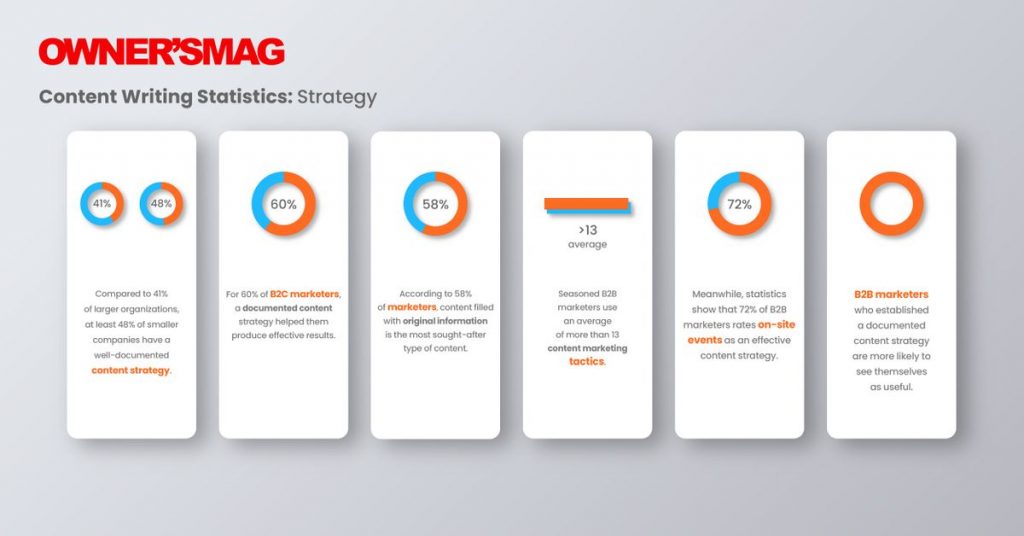
- CMI
Compared to 41% of larger organizations, at least 48% of smaller companies have a well-documented content strategy. Although we often encounter the term “documented” content strategy, what does it mean? Well, a documented content strategy is a set of actionable steps that’s been proven to produce predictable yet beneficial results.
- CMI
For 60% of B2C marketers, a documented content strategy helped them produce effective results.
- Social Media Examiner
According to 58% of marketers, content filled with original information is the most sought-after type of content. Furthermore, marketers prefer an “original” written kind of content over visuals and videos.
- TopRankBlog
Seasoned B2B marketers use an average of more than 13 content marketing tactics.
- TopRankBlog
Meanwhile, statistics show that 72% of B2B marketers rates on-site events as an effective content strategy.
- CMI
B2B marketers who established a documented content strategy are more likely to see themselves as useful.
- CMI
At least 73% of organizations have appointed a content strategy manager to oversee their brand’s content strategy.
- CMI
Furthermore, thanks to a content marketing manager, 86% of organizations are considered highly effective in content strategy.
- Custom Content Council
According to 72% of marketers, online branded content is essential than magazine advertisement. Besides, it exposes your brand’s original creative outputs to a broader set of audiences.
- Custom Content Council
For 69% of marketers, creative and useful content is more superior to direct emails and PR. Furthermore, it’s more accessible to wider audiences, may it be through organic research or paid online ads.
Blogging Strategy
- LookBookHQ
A majority of marketers use content repurposing as part of their content strategy. Almost 60% reuse “snackable” content two to five times. It’s one of the quickest ways to produce content if you aim at a consistent per-day release.
- TopRankBlog
A majority of B2B marketers outsource startups and content writers. 64% of marketers hire a freelance writer or subscribe to an on-demand content writing service.
- Contently
According to 50% of marketers, it’s desirable to measure their site visitors’ actual engagement and interest.
- CMI
Compared to 2020, 72% of marketers are producing more content than their previous track record.
- CMI
Did you know that over 2 million blogs are posted per day? We don’t want our content to drown amongst the sea of endless information. This is one of the reasons why SEO and consistent posting is essential.
- HubSpot
Online businesses who blog daily see a positive ROI from their inbound marketing, according to 82% of marketers. In the end, the more consistent you produce content, the higher ROI you achieve.
Content Marketing Platforms
- CMI
Social media is the most common platform for content marketing delivery. 87% of marketers utilized social media networks to increase the public’s awareness of their brand.
- CMI
While 76% of B2B marketers create blog content, 73% publish case studies. Most businesses publish case studies on their website to showcase customer experiences and testimonials about their product or service. It’s a more detailed and informative approach that shows how your business can help your potential customers.
- LookBookHQ
A total of 49% of marketers learn how to drive content and align it to the buyer’s journey.
- Social Media Examiner
A majority of marketers plan to increase content creation quality with original and informative information. 81% of marketers agree with this kind of approach.
- DemandGen
In 2020, infographics grew from 9%-52% and will only continue to grow in the following years.
- Unbounce
Meanwhile, the demand for infographics has increased by 800% in the past year.
- TopRankBlog
Most marketers use LinkedIn to distribute content. 81% of B2B marketers agree that LinkedIn is the number one choice for content relevant to professionals.
- TopRankBlog
Meanwhile, at least 73% of B2B marketers use Youtube as their content distribution platform. Statistics show that users spend a total of 6 billion hours viewing videos per month.
- CMI
For B2C marketers, an increase of 20% usage on LinkedIn is recorded this year.
- DemandGen
In 2014, content reading on mobile devices increased by 10% and continued to do so in the following years. Nowadays, mobile-friendly websites have a higher engagement for those who do not.
- LookBookHQ
According to 44% of marketers, they identify content production as the biggest challenge.
- CMI
Interactive content or “gamification” is considered the least common strategy used for marketing. In fact, only 10% of marketers produce one. However, this type of content is more effective in increasing user engagement on a brand’s website.
Content Writing Statistics – General
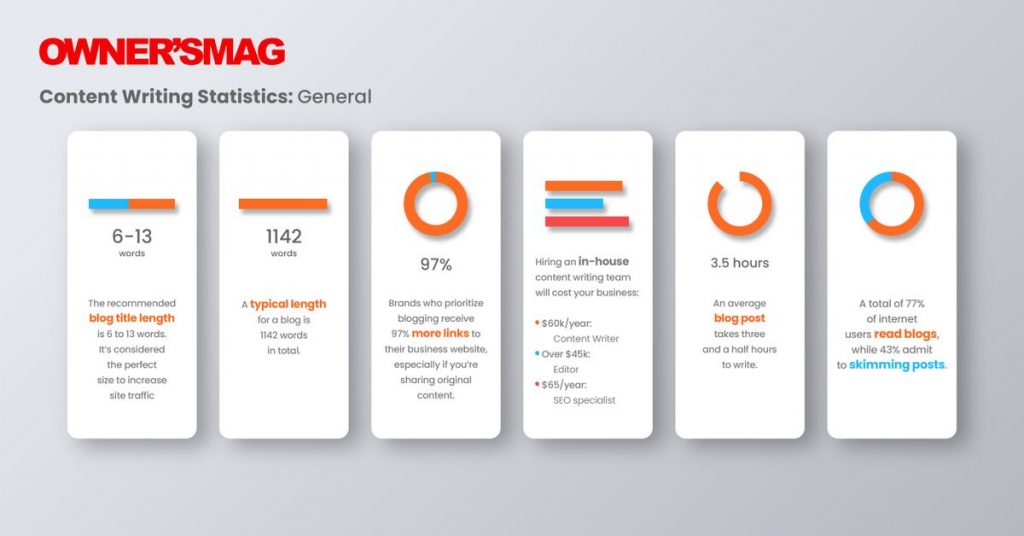
- HubSpot
The recommended length for blog titles is 6 to 13 words. It’s considered the perfect size to increase site traffic.
- Orbit Media
A typical length for a blog is 1142 words in total.
- HubSpot
Brands who prioritize blogging receive 97% more links to their business website, especially if you’re sharing original content.
- Glass Door
Hiring an in-house content writing team will cost your business:
- An approximate $60,000 per year for a content writer.
- Over $45,000 for an editor.
- $65,000 per year for an SEO specialist.
- OptinMonster
An average blog post takes three and a half hours to write.
- OptinMonster
A total of 77% of internet users read blogs, while 43% admit to skimming posts.
- OptinMonster
Only a total of 38% of bloggers update older articles. Meanwhile, 34% of bloggers advise that updating blog content produces beneficial results to the brand. Search engines love “fresh” up-to-date content.
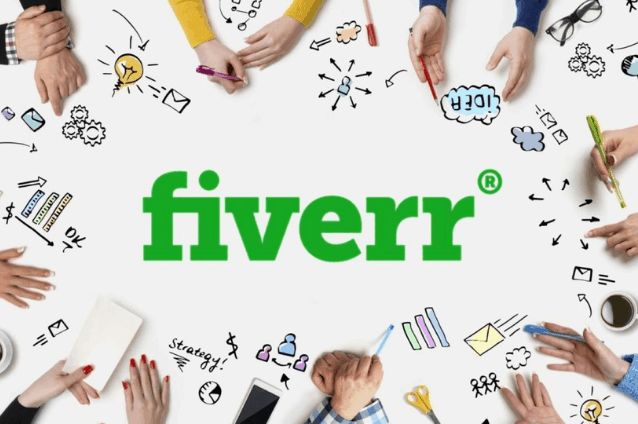
TL;DR: Penji leads Fiverr alternatives for businesses needing consistent design work at $499/month. Designjoy offers premium creative direction at $5,995/month. ManyPixels provides affordable, unlimited design at $549/month. Dribbble connects you with portfolio-vetted designers. Behance gives access to Adobe’s creative network.
Best Fiverr Alternatives:
- Penji: Unlimited designs for $499/month with US-based designers
- Designjoy: Premium subscription service at $5,995/month
- ManyPixels: Budget-friendly unlimited design at $549/month
- Dribbble: Direct access to portfolio-vetted designers
- Behance: Adobe’s creative network for finding talent
Why Are Business Owners Leaving Fiverr?
Some business owners find it difficult to search through numerous Fiverr profiles to find reliable designers. Frequently cited concerns include inconsistent quality, communication issues, and designers discontinuing work before completion.
Alternative freelance design platforms have emerged. Some platforms verify their designers, provide transparent pricing, and aim for reliable results. Here are services that support business needs.
Which Platforms Actually Work for Business Owners?
Penji: Best Value for Business Owners
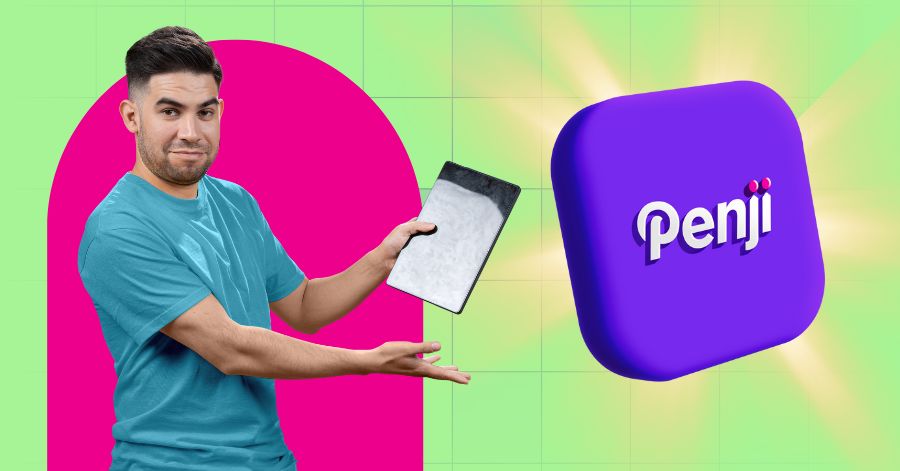
For $499 per month, businesses can submit multiple design requests without worrying about extra charges or negotiating prices. This option provides consistent graphic design support as needed.
Penji connects you with US-based designers who know your industry. They handle everything from social media graphics and presentations to logos and print materials. Most projects are completed in 24 to 48 hours, and you can request as many changes as you need. You can also pause your subscription whenever you want, which is helpful for businesses with changing needs.
Designjoy: Best for Premium Creative Work
Businesses seeking premium creative direction may consider Designjoy at $5,995 per month. Designers often bring experience with major brands. The service includes design quality, easy revisions, and a focus on thoughtful creative work.
ManyPixels: Best Budget Subscription Option
ManyPixels charges $549 per month for unlimited design requests. Their team is global, so projects usually take 48 to 72 hours, compared to Penji’s faster turnaround. This is a good fit for marketing teams that need many designs, such as ads, email headers, or social media templates.
Dribbble: Best for Finding Portfolio-Vetted Talent
Dribbble began as a platform for designers to display their work. Clients can contact designers directly for freelance or contract opportunities. Rates typically range from $50 to $300 per hour and are set between client and designer. The platform allows portfolio reviews before contact and does not charge additional platform fees.
Behance: Best for Adobe Creative Professionals
Behance is Adobe’s creative network where thousands of designers share their portfolios. You can’t hire designers directly through the site, but it’s a great place to find talent and contact them by email or LinkedIn. Many designers include their availability and contact details on their profiles, so it’s simple to get in touch.
How Do You Choose What Fits Your Business?
Penji offers both quality and cost considerations: access to US-based designers, fast turnaround, and unlimited requests are standard. Learn more about why businesses prefer Penji over traditional freelance marketplaces.
Designjoy may be suitable for businesses in markets where design quality is important for branding. ManyPixels can be an option for those prioritizing budget and adaptability over turnaround speed. See how Penji compares to Fiverr in terms of quality and reliability.
Ready to Stop Settling for Unreliable Design?
Businesses may benefit from exploring Penji’s subscription service to determine if reliable, high-quality design solutions meet their requirements. Browse through examples of completed projects to see the quality you can expect.
Frequently Asked Questions
Which Fiverr alternative is best for small business owners?
Penji works best for most small businesses because $499/month is affordable and includes unlimited design work. You avoid the time drain of managing freelancers while getting consistent quality. Only go premium (Designjoy) if your market demands it.
Can I pause these subscriptions if I don’t need design every month?
Yes. Penji, ManyPixels, and Designjoy all let you pause at any time. You only pay for months when you’re actively using the service, making it practical even for businesses with seasonal needs or unpredictable design requirements.
What types of design work do these platforms handle?
Penji covers logos, social media graphics, presentations, print materials, web design mockups, and packaging. Designjoy handles similar work plus strategic brand development. ManyPixels focuses on digital marketing assets. Most platforms handle everything except complex web development or animation.
How do subscription services compare to hiring a full-time designer?
A full-time designer costs $50,000-80,000 annually plus benefits. Penji runs $5,988/year with more flexibility. You get similar output without payroll overhead, equipment costs, or downtime when there’s no work. Plus, you can pause between busy periods.
Are the designers actually based in the US?
Penji uses US-based designers who understand American business culture and time zones. ManyPixels works with a global team across different time zones. Designjoy features experienced US designers. If location matters for communication and cultural fit, check each platform’s designer location before committing.

TLDR: Penji and Kimp do flat rate unlimited design (Kimp throws video in, too). ManyPixels is cheaper for digital assets and Designity is premium US-based creative direction for more complex projects.
These Superside alternatives made the cut, and a few stand apart from the rest. While there are relative pros and cons to each worth delving into, the features that matter most to your team and company goals will define what’s best for you. Here’s a shortlist of what stands out.
1 Penji

Penji is one of the best superside alternatives. It claims to be the simple graphic design subscription solution you need. With flat-rate pricing, it’s successful through its workforce acquisition efforts as they only hire the top 2% of designers worldwide, meaning there’s always a crew ready to take and execute reliable assignments from social graphics to print needs. Furthermore, they have a clean feedback process and queue meaning that marketing teams can rely on a sound platform solution that delivers over time for ongoing launches or efforts for foundational power.
Pros:
- Unlimited requests and revisions.
- Designers are dedicated, meaning they get to know the brand over time.
- Can do everything from web needs to print, advertising, and decks.
- Flat pricing makes budgeting easy for internal chargebacks.
Cons:
- The fastest turnaround time requires an upgrade.
2 ManyPixels

ManyPixels is one of the top up-and-coming Solutions thanks to ease of use and lower starting pricing. ManyPixels is a good choice for those companies that primarily need digital graphic assets and want something that’s easy to scale. It also includes motion and video editing, which makes it more versatile in its outputs as the plans increase.
Pros:
- Low starting prices are one of the lowest for entry-level efforts.
- Access to all digital and print graphic design.
- A dedicated design portal helps keep things clean.
- Can easily pause or cancel a subscription.
Cons:
- Higher plans include UI/UX and more extensive offerings.
- Important requests may take longer based on the request type.
- May be less strategic than an agency would be.
3 Kimp

For anyone with visually-driven campaigns on social media and web properties, Kimp believes it specializes in unlimited graphic design plus unlimited video design, thus allowing for easy access to motion graphics needs at a flat-rate subscription price. This is especially effective for companies looking to have the Graphics + Video combo.
Pros:
- The Graphics + Video combo plan is a unique offering.
- Team of dedicated graphic designers and video editors.
- Combines branding efforts through Canva and motion graphics needs.
- 7-day risk-free trial.
Cons:
- It’s not recommended for niche-specific designs (like UI/UX or web development).
- There are hard limits per project and queue requests.
- The price for video or combo plans are higher.
4 Designity

Finally, Designity operates as a managed service where a Creative Director is assigned to the customer who manages a team of domestic creatives who are specialists in their field (for designs, animations, etc.). This allows for more quality assurance from a domestic stance in a strategic alignment offering more creative accountability than online-only, ticketed request platforms like others.
Pros:
- Dedicated U.S.-based Creative Director runs requests.
- U.S.-based creative services mean sensitive brand work is safe.
- Great for complicated projects that need time and oversight.
- The full-service platform includes design, video, and animation.
Cons:
- Higher costs due to managed U.S.-based efforts.
- Takes longer than it’s worth for basic accountability measures.
- Only mid-market to enterprise offerings will make sense here due to costs.
Business
What are the Best Canva Alternatives for Designers and Marketers?
Published
5 days agoon
October 23, 2025
Many marketers love Canva as it allows them to create stunning graphics easily and affordably. In addition, it is also a favorite tool among many professional designers. However, Canva is one tool that many marketers and designers outgrow, thanks to its limitations. If you’re looking for the best Canva alternatives, here is our list of the top five:
Penji

A graphic design subscription platform, Penji, is the best Canva alternative for all business sizes. It offers unlimited graphic design services and revisions done by top-caliber designers. In as little as 24 to 48 hours, you’ll get your designs, reducing the risks of design bottlenecks and delays. All these for a flat rate, starting at $499 per month.
RelayThat

Looking for the best Canva alternative that offers design automation? RelayThat is the design partner you need. It can generate numerous branded visuals instantly, allowing you to get bulk designs quickly. Its key features include brand management, headline generator, one-click resize, and over 3 million free images.
VistaCreate

Previously known as Crello, VistaCreate is an excellent option for social media graphics, posters, and other marketing materials. It has an interface similar to Canva, making it an easy-to-use alternative. It also offers animated templates, a drag-and-drop editor, and print services through VistaPrint.
Stencil

Claiming to be “The Web’s Favorite Online Graphic Design Tool,” Stencil is an easy-to-use alternative to Canva. It offers a low learning curve, making it ideal for small teams, startups, bloggers, and social media managers. This tool lets you whip up blog headers, ad creatives, and other visual assets quickly.
Design Wizard

A powerful image and video editing tool, Design Wizard enables you to create both static and animated content. It offers a comprehensive template library that you can edit for all your design needs. It has a low learning curve, thanks to its beginner-friendly interface.

What’s the Best Fiverr Alternatives?

What’s the Best Superside Alternatives today?

What are the Best Canva Alternatives for Designers and Marketers?
What’s the Best Design Pickle Alternative?

Top Marketing Podcasts for 2025 You Should Be Following Today

What are the Best Social Media Post Design Services for Startups?

What’s the Best Package Design Service Agency?

Top Marketing Podcasts for 2025 You Should Be Following Today

What’s the Best Package Design Service Agency?
What’s the Best Design Pickle Alternative?

What are the Best Social Media Post Design Services for Startups?

What are the Best Canva Alternatives for Designers and Marketers?

What’s the Best Superside Alternatives today?


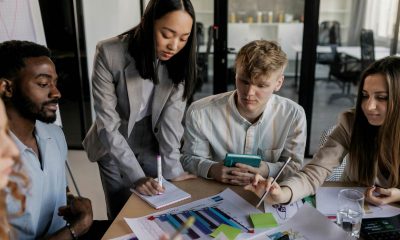

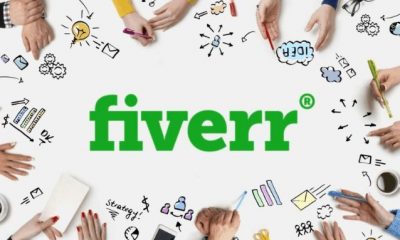
Pingback: Signs It's Time to Outsource Content Creation